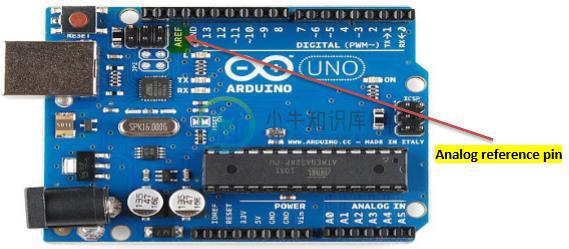Arduino - Advanced I/O Function
优质
小牛编辑
140浏览
2023-12-01
在本章中,我们将学习一些高级输入和输出功能。
analogReference() Function
配置用于模拟输入的参考电压(即用作输入范围顶部的值)。 选项是 -
DEFAULT - 默认模拟参考电压为5伏(在5V Arduino电路板上)或3.3伏电压(在3.3V Arduino电路板上)
INTERNAL - 内置参考电压,ATmega168或ATmega328等于1.1伏,ATmega8等电压为2.56伏(Arduino Mega不提供)
INTERNAL1V1 - 内置1.1V基准电压源(仅限Arduino Mega)
INTERNAL2V56 - 内置2.56V基准电压源(仅限Arduino Mega)
EXTERNAL - 施加到AREF引脚的电压(仅0至5V)用作参考
analogReference() Function Syntax
analogReference (type);
type - 可以使用任何类型的跟随(DEFAULT,INTERNAL,INTERNAL1V1,INTERNAL2V56,EXTERNAL)
对于AREF引脚上的外部参考电压,请勿使用低于0V或高于5V的电压。 如果在AREF引脚上使用外部参考,则必须在调用analogRead()函数之前将模拟参考设置为EXTERNAL。 否则,您将短接有效参考电压(内部产生)和AREF引脚,可能会损坏Arduino板上的微控制器。

或者,您可以通过5K电阻将外部参考电压连接到AREF引脚,从而可以在外部和内部参考电压之间切换。
请注意,电阻会改变用作参考电压的电压,因为AREF引脚上有一个内部32K电阻。 两者充当分压器。 例如,通过电阻施加的2.5V将在AREF引脚处产生2.5 * 32 /(32 + 5)= ~2.2V。
Example
int analogPin = 3;// potentiometer wiper (middle terminal) connected to analog pin 3
int val = 0; // variable to store the read value
void setup() {
Serial.begin(9600); // setup serial
analogReference(EXTERNAL); // the voltage applied to the AREF pin (0 to 5V only)
// is used as the reference.
}
void loop() {
val = analogRead(analogPin); // read the input pin
Serial.println(val); // debug value
}

